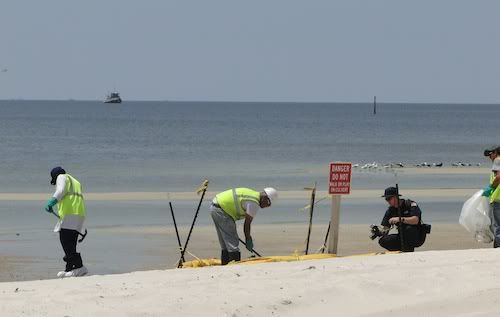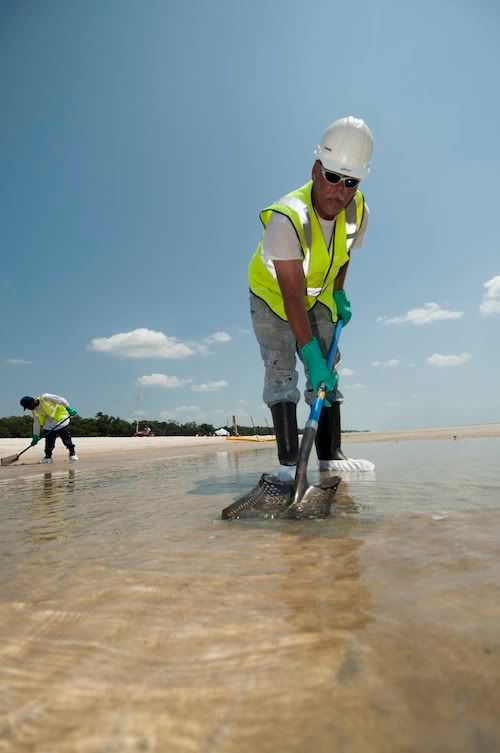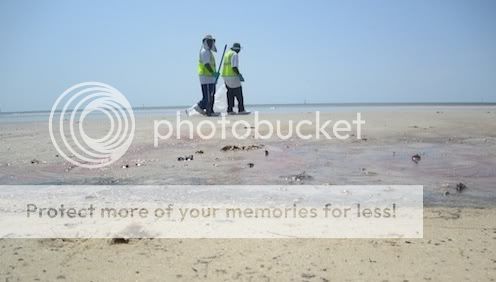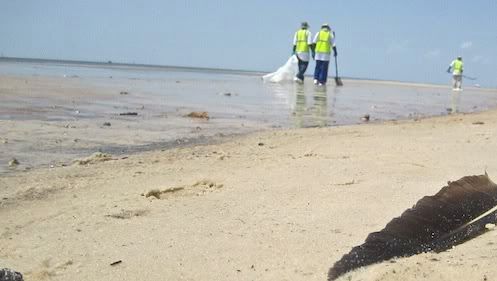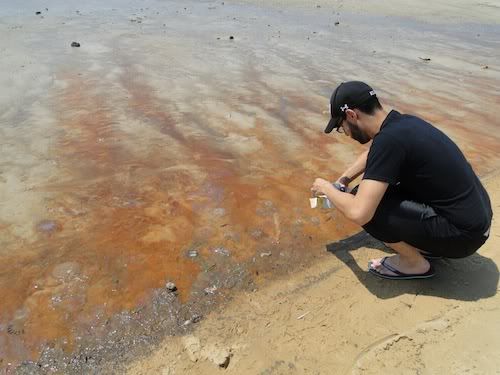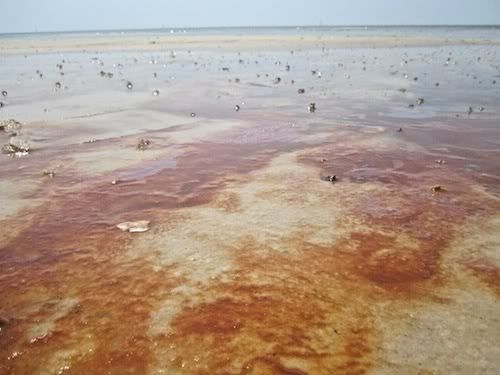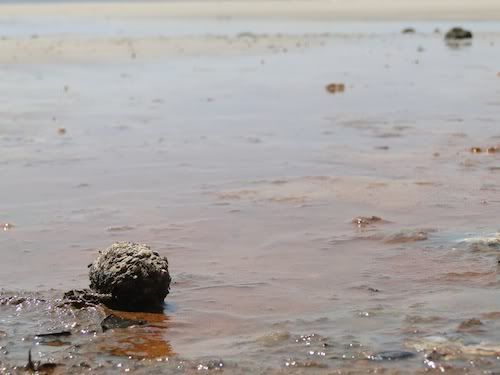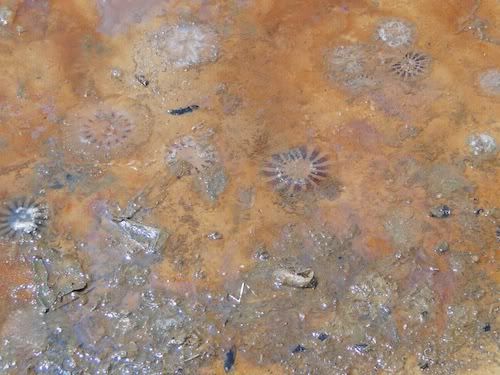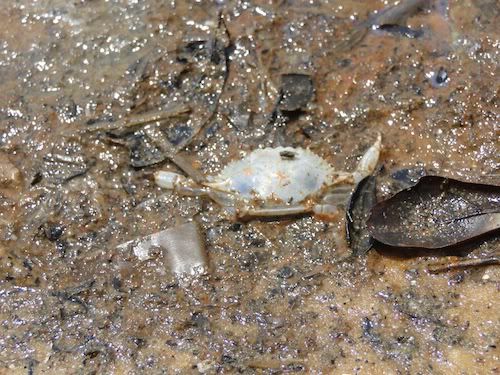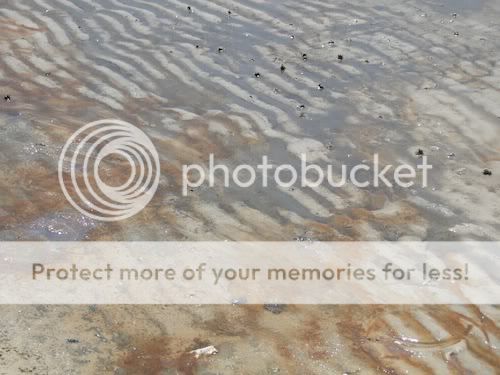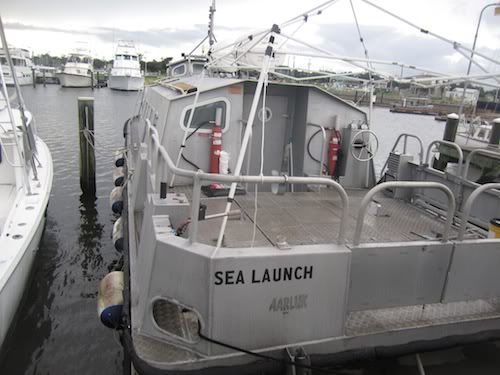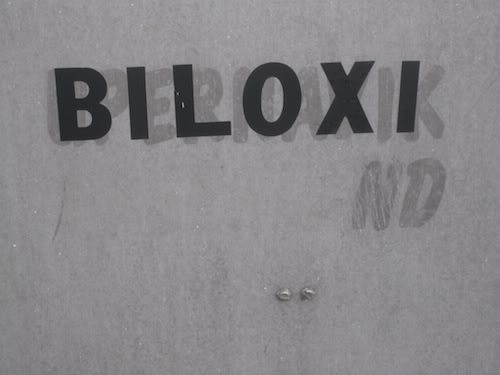Over the Labor Day weekend, the Perdido Bay Mullet Festival in Lillian, Alabama had to do something it’s never had to do before — substitute catfish for mullet. Why? Because, according to event organizer Bill Cornell, the company that supplies the mullet for the annual festival “didn’t feel good about the fish” and “won’t sell them for human consumption.” The seafood supplier, Wallace Seafood, had found unusual white spots on some of the mullet being caught, and won’t sell the fish until testing is completed to see if they’re safe to eat. According to the company’s Brent Wallace, “Mullet feed off the bottom and we don’t know what’s been down there.”
Another fisherman raised the same concern as Wallace Seafood — that mullet are bottom feeders so you don’t know what they’ve been eating — and added that because of their migratory nature, you also don’t know where they’ve been eating. This fisherman, nicknamed “Red,” who talked about the oil not being visible on the surface because the dispersants have made it sink down into the water, explained how mullet eat, sucking just about anything into what he called their “gizzard,” the black spot seen on the fish in the video below.
With the very unsurprising revelation reported by NPR last Monday that the oil from the BP oil spill isn’t gone, but has merely sunk to the sea floor, it’s no big leap to assume that the diet of these bottom-feeding, migratory fish is likely to include just about anything in that “fluffy and porous” layer of oil and “recently dead” things reported by Samantha Joye from the Department of Marine Sciences at the University of Georgia. As David Hollander of the University of South Florida is quoted as saying in the same NPR report, “A lot of fish go down to the bottom and eat and then come back up. And if all their food sources are derived from the bottom, then indeed you could have this impact.”
Bottom-feeding fish used as hog feed
Meanwhile, despite these concerns, bottom-feeding fish like mullet are currently being caught and eaten all over the Gulf, with the potential risk not being limited to direct human consumption of the fish, but indirectly by mullet being fed to hogs, as Dr. Norma Bowe of Kean University in New Jersey observed a few weeks ago. Striking up a conversation with some fishermen who were hauling in nets full of mullet from a pier in Long Beach, Mississippi, Dr. Bowe found out that one of the men was also a hog farmer who was catching the mullet to feed to his hogs. The hog farmer, who said he fishes from this pier every day, proudly told Bowe to just ask anybody and they’d tell her that his bacon, pork chops, ham hocks, and ribs are the best around, attributing the high quality of the meat from his hogs to their high protein fish diet. And, according to the fishermen that Bowe spoke to, these fish are also used in a variety of other products for both human and pet consumption — from Omega-3 fish oil supplements to cat food. Part of this conversation was caught on video by one of Bowe’s students.
Photos taken by Bowe and her students while this hog farmer was pulling in his catch show cleanup workers nearby in the background, obviously indicating that there was something very close to this pier in need of cleaning up. And, according to Bowe, the rocks under the pier were visibly coated with oil, which can clearly be seen in additional photos. Yet this pier is open for fishing. Was what Dr. Bowe and her students observed at this pier in Long Beach an isolated incident? Not according to “Red,” who has kept in touch with Bowe since her trip. “Red” reported finding crabs filled with oil just over a week ago at another pier in nearby Gulfport, which is also open for fishing.
Is the use of mullet as livestock feed an unusual practice? Not at all. Besides local hog farmers catching their own mullet to feed their own hogs, fish meal made from this type of fish is a common ingredient in commercially produced feed for both livestock and poultry, as well as feed for farm-raised seafood.
The initial concern of Dr. Bowe, who holds a Ph.D. in Community Health Policy, was the same as most other health professionals — the long term health effects of exposure to the oil and chemicals that people are coming in contact with: “My concern is for the public’s health. We know that short term exposure to the chemicals found in crude oil can cause skin rashes and lesions, headaches, fatigue, dizziness, and upper respiratory issues such as infections. Less is known about long term exposure, however benzene — a chemical contained in crude oil — is considered a carcinogen.” But, after the discovery that these same chemicals may be entering the food supply indirectly through livestock, Bowe added that studies of chemicals entering the food supply are also necessary: “Long term exposure studies are needed, as well as determining the effects if the chemicals reach the food supply.”
Is the FDA doing any special testing of this animal feed in the wake of the oil spill? Apparently not. In fact, Shannon Cameron, an FDA Health Communications Specialist, denied that Gulf fish are even being fed to livestock. In a message left in response to my question about whether or not testing was being done on the fish used in livestock feed, Cameron said, “I was forwarded your inquiry about Gulf fish being fed to livestock. It is not being fed to livestock.”
If Gulf fish are not being used for livestock feed, as Cameron asserts, then why would companies such as Omega Protein Corporation, which describes itself as “the nation’s largest manufacturer of heart-healthy fish oils containing Omega-3 fatty acids for human consumption, as well as specialty fish meals and fish oil used as value-added ingredients in aquaculture, swine and other livestock feeds,” be putting out press releases to its shareholders about the effects of the oil spill on its Gulf fishing operations? A June press release stated that “the Company’s Gulf of Mexico fish catch was 17 percent behind its Gulf of Mexico 2010 fish catch plan,” so the other 83 percent of its planned Gulf catch was obviously being caught.
The fish used by Omega Protein Corporation is menhaden, a forage fish which, like the mullet, has a filtering system. Prior to the BP oil spill, the biggest concern about menhaden was that their numbers were becoming so depleted because of their use in Omega-3 fish oil and livestock feed. In short, menhaden are a natural water filter, with each adult fish capable of filtering several gallons of water per minute, clearing the water of excess algae to allow the sunlight to get to oxygen producing undersea plant life. One can only guess what the menhaden in the Gulf are now filtering out of the water there.
Numerous samples now at Kean University for independent testing
Backing up a bit to explain how Kean University became involved in collecting samples from the Gulf, it all started in July, when Dr. Bowe and a group of students from the university’s Be the Change group took a trip to New Orleans to help an elderly woman whose home had been in need of repairs and painting since Hurricane Katrina. Months earlier, while planning this trip, the oil spill happened, so the students decided that after completing their volunteer project in New Orleans, they would spend a few days in the the area affected by the spill, volunteering to help with the cleanup. By July, however, the Deepwater Horizon Response Unified Command had seized control of volunteer efforts from the organizations that had been recruiting volunteers, so the group’s plan to volunteer through an organization they had contacted back in May was off. Undeterred, the students simply asked around and found the nearest beach where a cleanup effort was underway, still hoping to find a way to help. The beach they ended up on was in Pass Christian, Mississippi.
The disparities between what the group observed on this beach in July and what they were hearing from official sources made Bowe decide that she had to go back to find out what was really going on. So, on August 26, she returned, accompanied by two of the students from the first trip, Kayla Duncan and Nicolette Maggio. This time, Bowe was on a mission to collect samples for testing. And collect samples she did — over sixty of them — evading the obstacles reported by others, such as the confiscation of samples collected on public beaches, run-ins with local law enforcement, and the blocking of access to research sites to prevent non-BP or non-government scientists from doing independent testing.
While some of Bowe’s success in collecting such a large number of samples, many from areas that few have been able to access, can be chalked up to sheer resourcefulness, much more must be attributed to her people skills. By simply spending a little time with local workers and fishermen, and showing them that she was in this for the long haul, Bowe and her students quickly found themselves on a boat with “Red,” being taken to areas where the fishermen — probably the best judges of what doesn’t look right — thought that testing should be done, and what in particular they want to see tested.
The wide variety of samples collected on this trip are now in a lab at Kean, with the testing being performed by a group of scientists made up of Dr. Jeffrey Toney, the university’s Dean of Natural, Applied, and Health Sciences, (who is already covering the effects of the spill at NJ Voices), and other members of the science faculty. While all handling of the samples has been restricted to faculty members, one student, Mario DaCosta, will be permitted to observe and assist. As one of the students on Be The Change’s first Gulf trip in July, DaCosta, a chemistry major, has earned the opportunity to see the project through by being in on the sample testing.
In addition to the scores of water, sand, soil, plant, and biological samples collected by Bowe and her students, the samples now at Kean for testing include a few from other sources. One of these came from a tackle shop owner who, while cleaning up the mess that was washing up behind his shop, was told that he wasn’t allowed to be handling what was behind his shop because he didn’t have the proper training to be handling hazardous materials. The shop owner kept a sample of what he had been cleaning up, holding onto it until he could put it into good hands, and those hands were Dr. Bowe’s.
What’s up with the Coast Guard?
On the first trip in July, the Kean University group was told by an employee from the company doing the cleanup of the Pass Christian beach that he had been alarmed by the hundreds (if not thousands) of dead jellyfish that were covering the beach. The employee had reported his concerns to the Coast Guard, but was told by a Coast Guard scientist that the oily substance being left on the beach by the dead jellyfish was just the natural organic matter left when jellyfish decompose. Not buying this explanation, one of the students, Benito Nieves, snuck a sample of the decomposing jellyfish mess into a water bottle, and, although anyone with a properly functioning nose could tell that the substance in this water bottle was full of oil, the sample was delivered to Dr. Toney.
But this wasn’t the only thing that raised questions about the Coast Guard among the Kean students. On July 31, while the group was on the Pass Christian beach, a Coast Guard photographer arrived to shoot photos of the workers. The students took numerous photos of this Coast Guard photographer during the ten minutes that he was posing and shooting his photos of two workers. The students photos, a few of which are below, show exactly where the Coast Guard photographer and workers were positioned throughout the photo shoot.
But, in the final photo posted on the Coast Guard website, the workers, one of whom appears to be hard at work stirring the crystal clear water with his shovel, are not standing where the students’ photos show them being posed and photographed. According to the date and time listed on the Coast Guard website for this photo, there is no question that this was the photo that the students witnessed and photographed the Coast Guard photographer taking. (The second student photo above shows where the photographer and workers were positioned at 1:04 p.m. The time on this Coast Guard photo is 1:05 p.m.)
(The original high res photo can be downloaded here.)
According to Bowe and her students, who had walked this entire stretch of beach, there was no place on this beach that looked anything like what appears in the Coast Guard photo. Here are some of the photos taken by the students, who, in addition to those already mentioned in this article, included Elissa Hyer, Alexandra Bastos, and Rebecca Bowe. This is what was on the beach right where the Coast Guard photographer was shooting his photo of the workers. (The video clip at the end pans around to show where the students took these photos in relation to the yellow boom where the Coast Guard photographer was positioned.)
Here’s another photo taken by the same Coast Guard photographer, on the same beach in Pass Christian a little earlier that same day, again showing crystal clear water and not a tar ball in sight.
(The original high res photo can be downloaded here.)
But look at this video, released by the Coast Guard itself. The video, of the same two workers, in the same spot, shot by the same photographer, on the same day, shows water and sand not nearly as clean as in the photo, with the workers finding numerous tar balls. As they say on Sesame Street, “One of these things is not like the other.”
That many Mississippians can’t be wrong
The towns mentioned in this article — Pass Christian, Long Beach, and Gulfport — are three towns right in a row within a few miles of each other. This is the same stretch of Mississippi’s coast reported on by Truthout in Monday 13 September 2010’s article “Evidence Mounts of BP Spraying Toxic Dispersants.” It would be almost redundant to report any more of what the fishermen who talked to the Kean University group said they’ve seen, because it would essentially just confirm much of what Truthout’s Dahr Jamail was told by Pass Christian residents Shirley and Don Tillman, and what many other Mississipians have been saying. Unless one of the effects of the oil spill has been collective hallucinations, what these people are reporting is what’s really happening.
One thing should be added, however, about those suspicious out of state boats in BP’s Vessels Of Opportunity (VOO) program, described by the Tillmans, which seem to be a subject of particular opprobrium to the local residents. These boats might not just have been brought in from other states, but from another country. Photos taken by the Kean students of one of these boats, on which little care was taken to completely cover up the boat’s prior information, show that this boat’s name was changed from the “Aarluk” to the “Sea Launch,” and “Biloxi” was slapped over “Upernavik.” Where is Upernavik? Well, that’s in Greenland.
Editor’s note: Rodda works for the Military Religious Freedom Foundation, whose president and founder, Mikey Weinstein, is a member of Truthout’s Board of Advisers.
We’re resisting Trump’s authoritarian pressure.
As the Trump administration moves a mile-a-minute to implement right-wing policies and sow confusion, reliable news is an absolute must.
Truthout is working diligently to combat the fear and chaos that pervades the political moment. We’re requesting your support at this moment because we need it – your monthly gift allows us to publish uncensored, nonprofit news that speaks with clarity and truth in a moment when confusion and misinformation are rampant. As well, we’re looking with hope at the material action community activists are taking. We’re uplifting mutual aid projects, the life-sustaining work of immigrant and labor organizers, and other shows of solidarity that resist the authoritarian pressure of the Trump administration.
As we work to dispel the atmosphere of political despair, we ask that you contribute to our journalism. Over 80 percent of Truthout’s funding comes from small individual donations from our community of readers, and over a third of our total budget is supported by recurring monthly donors.
9 days remain in our fundraiser, and you can help by giving today. Whether you can make a small monthly donation or a larger gift, Truthout only works with your support.

